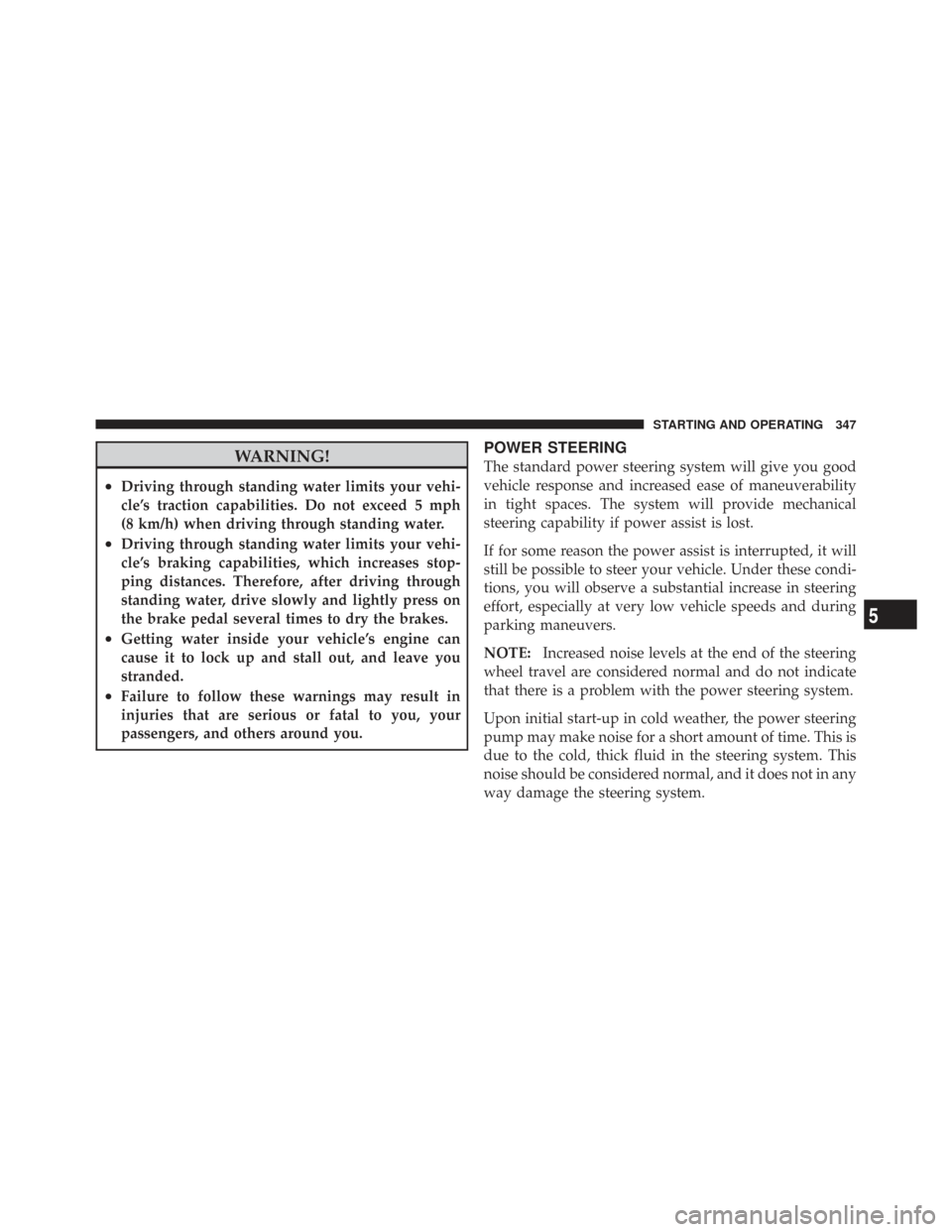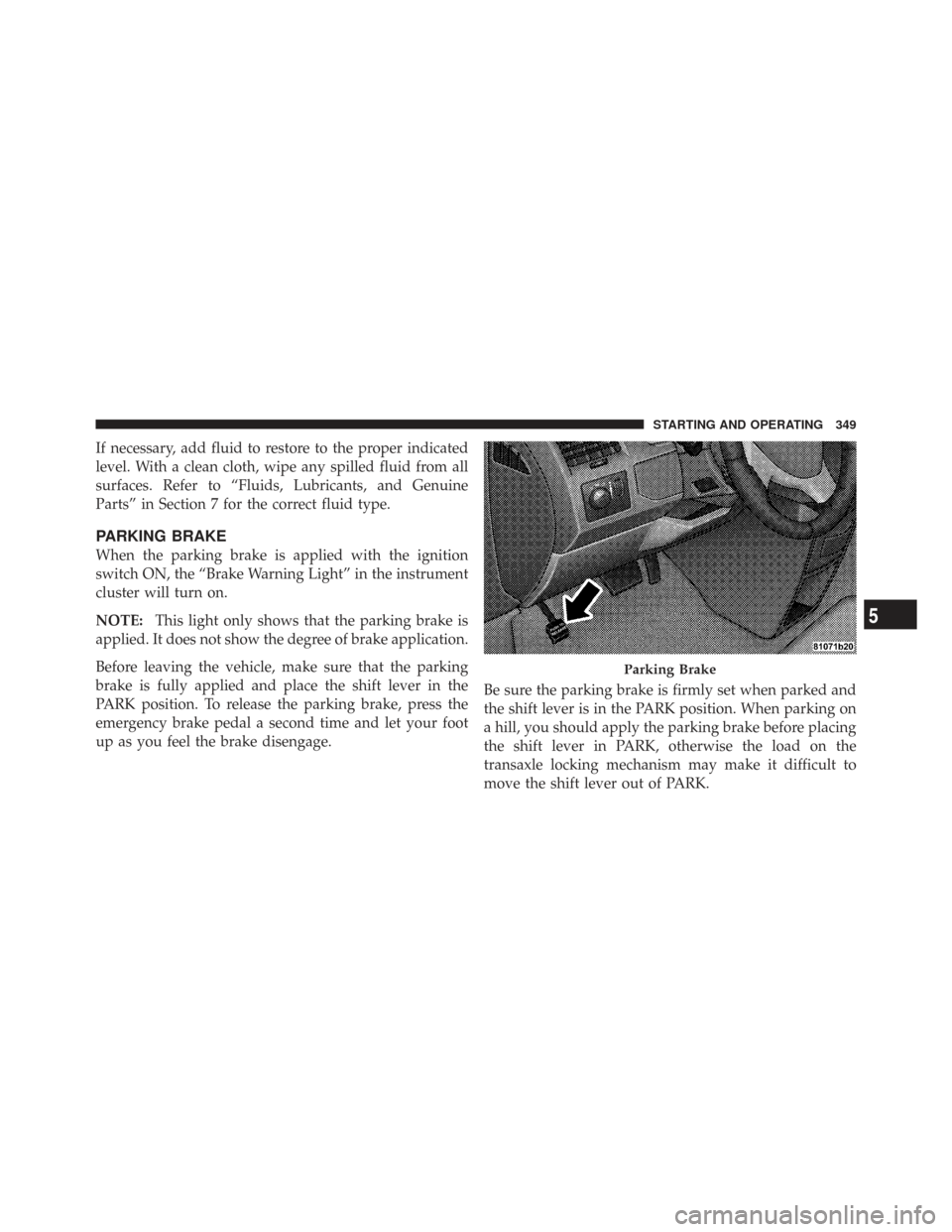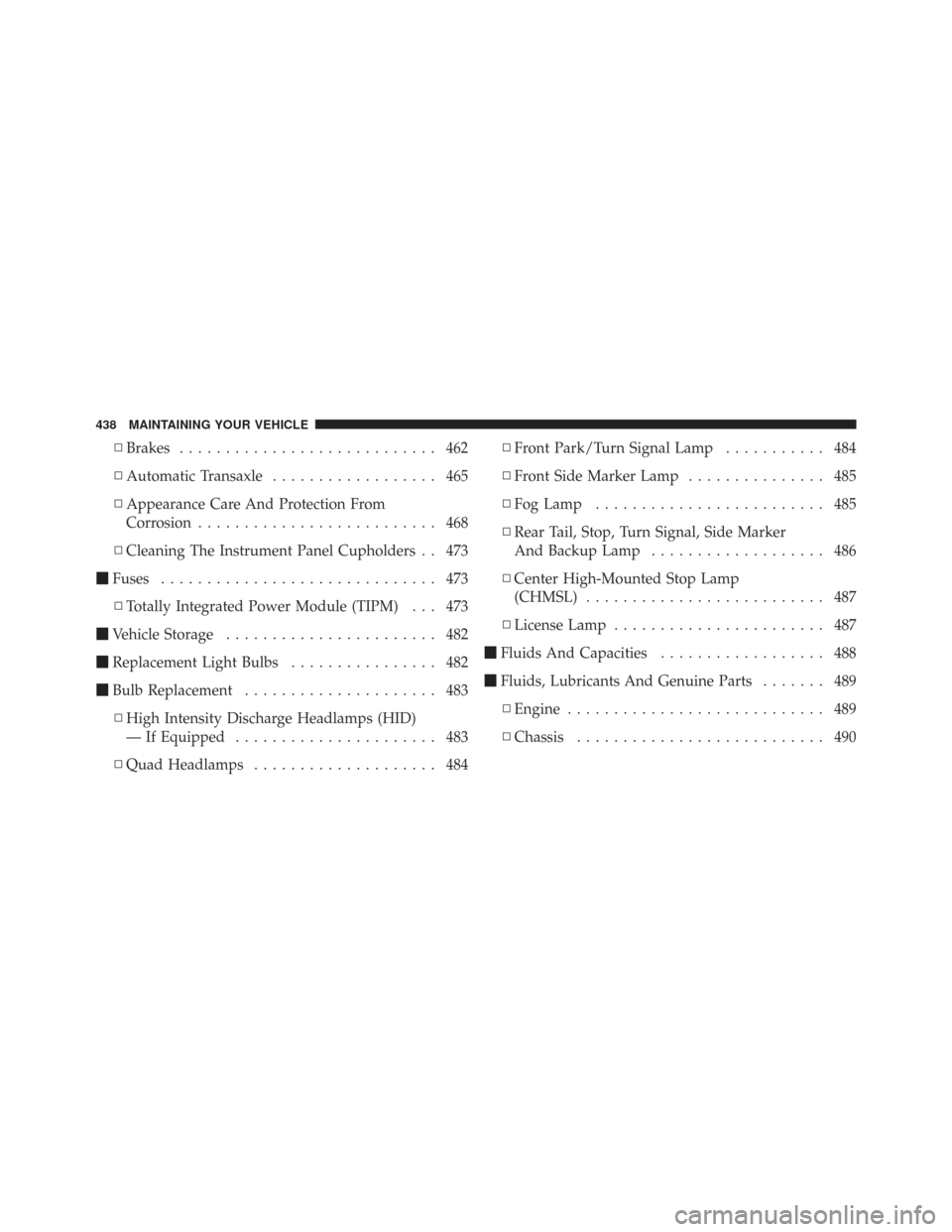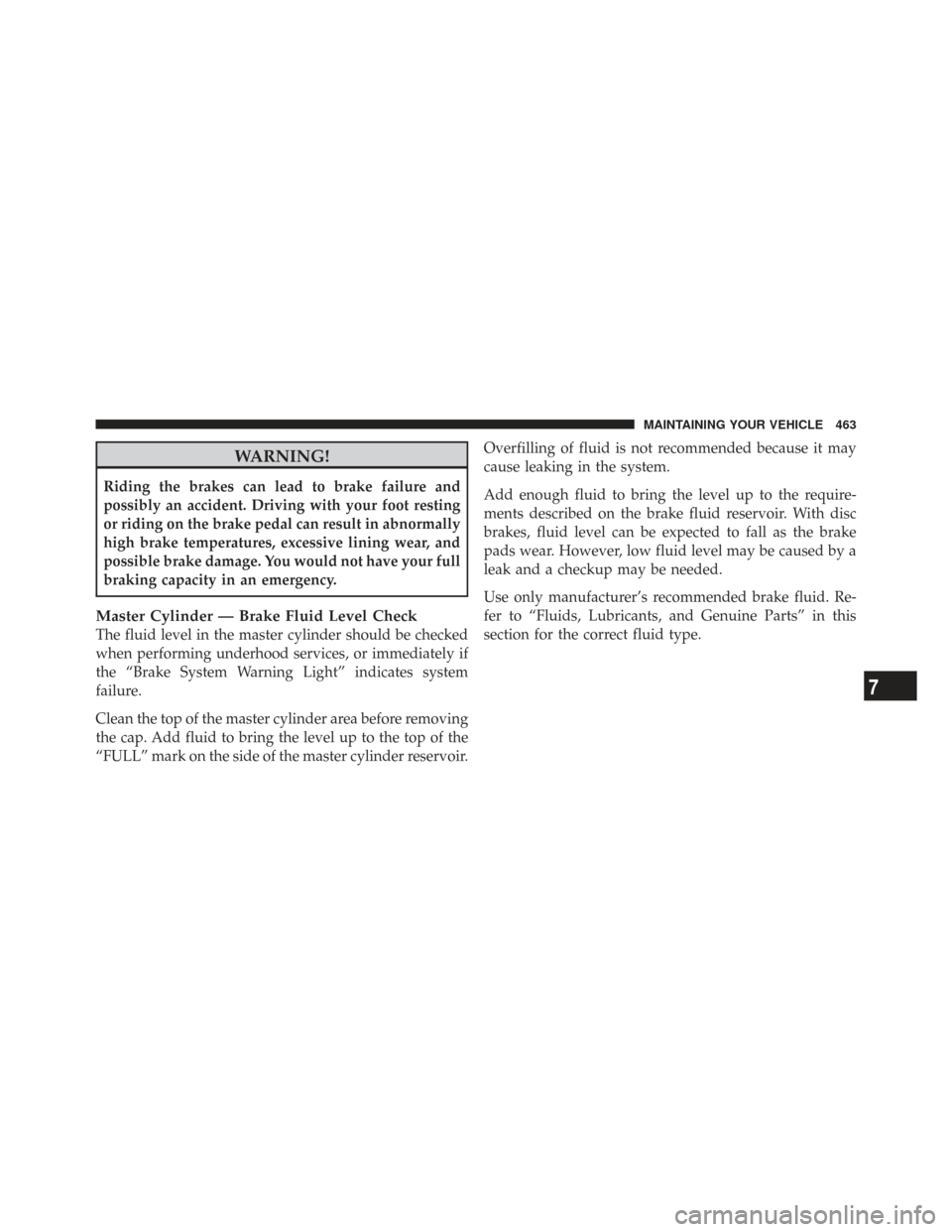Page 334 of 543

▫Shallow Standing Water .............. 345
� Power Steering ...................... 347
▫ Power Steering Fluid Check ........... 348
� Parking Brake ....................... 349
� Anti-Lock Brake System (ABS) ........... 350
▫ Anti-Lock Brake Warning Light ......... 352
� Electronic Brake Control System .......... 353
▫ Traction Control System (TCS) .......... 353
▫ Brake Assist System (BAS) ............. 354
▫ Electronic Stability Program (ESP) ....... 355
▫ ESP/BAS Warning Light .............. 356
� Tire Safety Information ................ 357
▫ Tire Markings ..................... 357 ▫
Tire Identification Number (TIN) ........ 361
▫ Tire Loading And Tire Pressure ......... 362
� Tires — General Information ............ 366
▫ Tire Pressure ...................... 366
� Tire Chains ......................... 373
� Snow Tires ......................... 375
� Tire Rotation ........................ 375
� Tire Pressure Monitor System (TPMS) ...... 376
▫ Base System ....................... 378
▫ Premium System — If Equipped ........ 380
� Fuel Requirements .................... 384
▫ 3.3L/3.8L Gasoline Engine ............. 384
▫ 4.0L Gasoline Engine ................ 385
332 STARTING AND OPERATING
Page 349 of 543

WARNING!
•Driving through standing water limits your vehi-
cle’s traction capabilities. Do not exceed 5 mph
(8 km/h) when driving through standing water.
•Driving through standing water limits your vehi-
cle’s braking capabilities, which increases stop-
ping distances. Therefore, after driving through
standing water, drive slowly and lightly press on
the brake pedal several times to dry the brakes.
•Getting water inside your vehicle’s engine can
cause it to lock up and stall out, and leave you
stranded.
•Failure to follow these warnings may result in
injuries that are serious or fatal to you, your
passengers, and others around you.
POWER STEERING
The standard power steering system will give you good
vehicle response and increased ease of maneuverability
in tight spaces. The system will provide mechanical
steering capability if power assist is lost.
If for some reason the power assist is interrupted, it will
still be possible to steer your vehicle. Under these condi-
tions, you will observe a substantial increase in steering
effort, especially at very low vehicle speeds and during
parking maneuvers.
NOTE:Increased noise levels at the end of the steering
wheel travel are considered normal and do not indicate
that there is a problem with the power steering system.
Upon initial start-up in cold weather, the power steering
pump may make noise for a short amount of time. This is
due to the cold, thick fluid in the steering system. This
noise should be considered normal, and it does not in any
way damage the steering system.
5
STARTING AND OPERATING 347
Page 351 of 543

If necessary, add fluid to restore to the proper indicated
level. With a clean cloth, wipe any spilled fluid from all
surfaces. Refer to “Fluids, Lubricants, and Genuine
Parts” in Section 7 for the correct fluid type.
PARKING BRAKE
When the parking brake is applied with the ignition
switch ON, the “Brake Warning Light” in the instrument
cluster will turn on.
NOTE:This light only shows that the parking brake is
applied. It does not show the degree of brake application.
Before leaving the vehicle, make sure that the parking
brake is fully applied and place the shift lever in the
PARK position. To release the parking brake, press the
emergency brake pedal a second time and let your foot
up as you feel the brake disengage. Be sure the parking brake is firmly set when parked and
the shift lever is in the PARK position. When parking on
a hill, you should apply the parking brake before placing
the shift lever in PARK, otherwise the load on the
transaxle locking mechanism may make it difficult to
move the shift lever out of PARK.
Parking Brake
5
STARTING AND OPERATING 349
Page 353 of 543
You may experience the following when the brake system
goes into anti-lock:
•The ABS motor running (it may continue to run for a
short time after the stop)
•A clicking sound of solenoid valves
•Brake pedal pulsations
•A slight drop or fall away of the brake pedal at the end
of the stop
WARNING!
•The Anti-Lock Brake System contains sophisti-
cated electronic equipment that may be suscep-
tible to interference caused by improperly in-
stalled, or high output radio transmitting
equipment. This interference can cause possible
loss of anti-lock braking capability. Installation of
such equipment should be performed by qualified
professionals.
•Pumping of the anti-lock brakes will diminish
their effectiveness and may lead to an accident.
Pumping makes the stopping distance longer. Just
press firmly on your brake pedal when you need
to slow down or stop.(Continued)
5
STARTING AND OPERATING 351
Page 354 of 543

WARNING! (Continued)
•The Anti-Lock Brake System cannot prevent acci-
dents, including those resulting from excessive
speed in turns, following another vehicle too
closely, or hydroplaning. Only a safe, attentive,
and skillful driver can prevent accidents.
•The capabilities of an ABS-equipped vehicle must
never be exploited in a reckless or dangerous
manner, which could jeopardize the user ’s safety
or the safety of others.
All vehicle wheels and tires must be the same size and
type, and tires must be properly inflated to produce
accurate signals for the computer.
Anti-Lock Brake Warning Light
The “Anti-Lock Brake Warning Light” moni-
tors the anti-lock brake system. The light will come on when the ignition switch is turned to the ON
position and may stay on for as long as four seconds.
If the “Anti-Lock Brake Warning Light” remains on or
comes on while driving, it indicates that the anti-lock
portion of the brake system is not functioning and that
service is required. However, the conventional brake
system will continue to operate normally if the “Brake
Warning Light” is not on.
If the “Anti-Lock Brake Warning Light” is on, the brake
system should be serviced as soon as possible to restore
the benefits of anti-lock brakes. If the “Anti-Lock Brake
Warning Light” does not come on when the ignition
switch is turned to the ON position, have the bulb
repaired as soon as possible.
If both the “Brake Warning Light” and the “Anti-Lock
Brake Warning Light” remain on, the ABS and Electronic
352 STARTING AND OPERATING
Page 355 of 543

Brake Force Distribution (EBD) systems are not function-
ing. Immediate repair to the ABS system is required.
Consult with your authorized dealer service center as
soon as possible.
ELECTRONIC BRAKE CONTROL SYSTEM
Your vehicle is equipped with an advanced electronic
brake control system that includes the Traction Control
System (TCS), Brake Assist System (BAS) and Electronic
Stability Program (ESP). These systems complement the
Anti-Lock Brake System (ABS) by optimizing the vehicle
braking capability during emergency braking maneu-
vers.
Traction Control System (TCS)
The Traction Control System (TCS) monitors the amount
of wheel spin of each of the driven wheels. If wheel spin
is detected, brake pressure is applied to the slipping
wheel(s) and engine power is reduced, to provide en-
hanced acceleration and stability. A feature of the TCSfunctions similarly to a limited-slip differential, and
controls the wheel spin across a driven axle. If one wheel
on a driven axle is spinning faster than the other, the
system will apply the brake of the spinning wheel. This
will allow more engine torque to be applied to the wheel
that is not spinning. This feature remains active even if
the ESP is in the “Partial Off” mode.
The “ESP/TCS Indicator Light” (in the instru-
ment cluster) will start to flash as soon as the
tires lose traction and the wheels begin to spin.
This indicates that the TCS is active. If the
indicator light flashes during acceleration, ease up on the
accelerator and apply as little throttle as possible. Be sure
to adapt your speed and driving to the prevailing road
conditions, and do not switch off the ESP or TCS.
5
STARTING AND OPERATING 353
Page 440 of 543

▫Brakes ............................ 462
▫ Automatic Transaxle .................. 465
▫ Appearance Care And Protection From
Corrosion .......................... 468
▫ Cleaning The Instrument Panel Cupholders . . 473
� Fuses .............................. 473
▫ Totally Integrated Power Module (TIPM) . . . 473
� Vehicle Storage ....................... 482
� Replacement Light Bulbs ................ 482
� Bulb Replacement ..................... 483
▫ High Intensity Discharge Headlamps (HID)
— If Equipped ...................... 483
▫ Quad Headlamps .................... 484 ▫
Front Park/Turn Signal Lamp ........... 484
▫ Front Side Marker Lamp ............... 485
▫ Fog Lamp ......................... 485
▫ Rear Tail, Stop, Turn Signal, Side Marker
And Backup Lamp ................... 486
▫ Center High-Mounted Stop Lamp
(CHMSL) .......................... 487
▫ License Lamp ....................... 487
� Fluids And Capacities .................. 488
� Fluids, Lubricants And Genuine Parts ....... 489
▫ Engine ............................ 489
▫ Chassis ........................... 490
438 MAINTAINING YOUR VEHICLE
Page 465 of 543

WARNING!
Riding the brakes can lead to brake failure and
possibly an accident. Driving with your foot resting
or riding on the brake pedal can result in abnormally
high brake temperatures, excessive lining wear, and
possible brake damage. You would not have your full
braking capacity in an emergency.
Master Cylinder — Brake Fluid Level Check
The fluid level in the master cylinder should be checked
when performing underhood services, or immediately if
the “Brake System Warning Light” indicates system
failure.
Clean the top of the master cylinder area before removing
the cap. Add fluid to bring the level up to the top of the
“FULL” mark on the side of the master cylinder reservoir.Overfilling of fluid is not recommended because it may
cause leaking in the system.
Add enough fluid to bring the level up to the require-
ments described on the brake fluid reservoir. With disc
brakes, fluid level can be expected to fall as the brake
pads wear. However, low fluid level may be caused by a
leak and a checkup may be needed.
Use only manufacturer’s recommended brake fluid. Re-
fer to “Fluids, Lubricants, and Genuine Parts” in this
section for the correct fluid type.
7
MAINTAINING YOUR VEHICLE 463